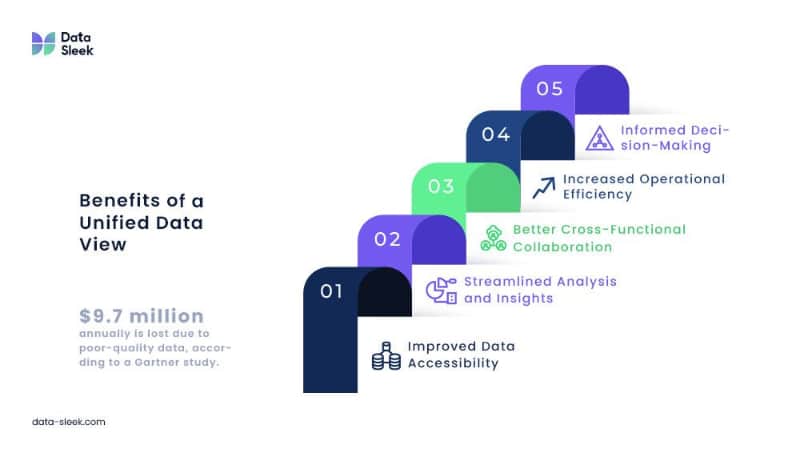Let’s face it, data is king (or queen). For many businesses, that data is like a toddler with a box of crayons–scattered everywhere, leaving a colorful mess. That fragmented data trapped in isolated databases is what we call data silos.
Data silos are the enemy of progress. They hinder informed decision-making, create a frustrating customer experience, and leave you drowning in a sea of information without a clear view of the bigger picture. Fear not, fellow data wrangler. There’s a solution: unified data management.
Think of it like Marie Kondo for your business intelligence. A unified data view combines all of your information, from marketing automation platforms to customer relationship management (CRM) tools, into one beautiful, organized haven. It’s the key to unlocking the true power of your data and transforming your business from a data dinosaur to a unified data-driven dynamo.
Today, we’re diving into the world of unified data management and breaking down everything you need to know about unifying your disparate data.
What Is A Unified Data View?
A unified data view consolidates data from multiple sources into a single, integrated perspective. This approach ensures consistency and accuracy. It provides a comprehensive view that supports better decision-making and streamlined operations. By integrating data from various systems and databases, a unified data view eliminates redundancies that skew insights.
Unified data management enables batch processing and real-time analytics for a holistic view of business metrics. Pooling data together in a single source of truth allows for more proactive and strategic management across all levels of the organization.

Benefits of a Unified Data View
Organizations like yours experience remarkable benefits whether you’re unifying data from 2 or 200 sources. Some of those benefits include:
- Improved Data Accessibility: Teams quickly find needed information, allowing sales to tailor pitches effectively.
- Streamlined Analysis and Insights: Simplifies analysis, enabling data analysts to generate actionable insights faster.
- Better Cross-Functional Collaboration: Shared data enhances communication and strategy alignment across departments.
- Increased Operational Efficiency: Integrated processes boost productivity and optimize inventory management using real-time data.
- Informed Decision-Making: A holistic data perspective supports strategic and informed decisions by executives with a complete business view.
Consider the facts: A Gartner study reported annual losses of $9.7 million due to poor-quality data. Organizations in the telecom and transportation sectors have the highest rates of cash burn and losses related to bad data.
Industries That Benefit from Unifying Data
Note that virtually every industry benefits from data unification. Without an exhaustive analysis, here are a few major industries and how they can benefit from unified data management:
- Manufacturing and Supply Chain: Integrating supplier, inventory, and distribution data can lead to better demand planning and inventory management.
- Telecommunications and Media: Telecom companies can enhance customer satisfaction and reduce churn by consolidating network, usage, billing, and even geospatial data.
- Public Sector and Government: Integrated citizen data across agencies enhances service delivery and policy analysis. For example, unlocking insights on state-funded projects like trash collection can help allocate resources to higher-demand areas while reducing frequencies in less needy areas. This approach ensures more efficient use of public resources and improves overall service effectiveness.
Consider the facts: In a recent report, 78% of executives reported difficulty using their data for effective decision-making because of unified data management roadblocks.

Real-Life Application: Creating a Unified View of Customer Data
Industry reports indicate that companies utilizing unified data are better equipped to understand their customers. However, siloed data across multiple sources makes obtaining a comprehensive and accurate view near impossible. This, of course, is a problem. The 360-degree view is essential for delivering personalized experiences.
Some standard methods for achieving a unified customer data view are:
- Data Integration and Consolidation: Using extract, transform, load (ETL) processes and data warehouses to bring together data from disparate sources.
- Master Data Management and Identity Resolution: Master data management ensures data accuracy and consistency by resolving duplicate records and creating a unified database.
- Data Quality and Governance: Implementing processes to maintain high data quality, such as regular data cleansing and validation.

How You Can Create A Unified Data View in Your Organization
Unified data warehouses within your organization will differ depending on your current data architecture and unique business needs. Most organizations can unify their data using the following steps.
1. Conduct a Data Audit
Assess your existing data sources, such as databases, applications, and spreadsheets. Engage data owners and stakeholders from various departments to ensure comprehensive data integration.
2. Define Data Governance Standards
Establish data governance policies to manage data quality, security, and compliance. To ensure consistency, you’ll also want to define standards for data formats, taxonomies, and naming conventions.
3. Implement Data Integration and Consolidation
Implementing unified data architecture often involves using ETL (Extract, Transform, Load) tools. These tools extract data from various data sources, transform it into a consistent format, and load it into a centralized repository.
Data warehouses and data lakes are commonly used to store and manage large volumes of data. Additionally, data virtualization tools enable real-time access to unified data without needing physical consolidation, ensuring seamless data integration and accessibility.
4. Develop a Centralized Data Access Layer
A centralized data access layer includes creating a centralized access point for unified data, such as a data hub or portal. Implementing data catalogs to organize and manage data assets and providing self-service analytics tools empower users to analyze data independently.
5. Ensure Data Security and Compliance
Implement robust data security measures, such as encryption, access controls, and regular audits. This step might also include ensuring compliance with relevant data protection regulations and industry standards.
6. Foster a Data-Driven Culture
Encouraging a culture that values data-based business decisions and continuous learning can help maximize your ROI. To promote a data culture in your organization, consider providing training programs and resources to help employees develop data literacy skills and use data tools effectively.

Key Challenges and Considerations When Unifying Disparate Data Sources
As technology continues to evolve, so do the challenges that come with it. Many common roadblocks that organizations encounter have simple solutions:
- Legacy Systems and Technical Debt: Holding onto old systems for the sake of data is a thing of the past. Choose to modernize outdated systems that enable your organization to support integration and scalability.
- Cultural Resistance and Change Management: Not everyone is excited about change. Overcome resistance by promoting the benefits of a unified data approach. Involving stakeholders can familiarize them with the process and, in turn, lower their defenses.
- Security and Compliance Requirements: To protect sensitive data, implement strong security measures and comply with regulatory requirements. Policies and regulations are constantly evolving, and so should your data management.
Hiring a Professional for Data Unification
If you’re like most businesses without a dedicated IT, in-house data scientists, or data management department, hiring a professional is the next logical step. Here’s how we can help your organization:
- Expertise and Experience: Our consultants bring specialized knowledge and experience handling complex data projects. We follow best practices to ensure seamless integration.
- Time and Cost Efficiency: With three decades of experience, we’ve seen it all. Our professionals can streamline the data unification process, allowing you to save valuable time and enjoy reduced costs associated with errors and delays. Or, even worse, choosing the wrong data warehouse or data lake vendor.
- Tailored Solutions: We provide customized strategies aligning with your business requirements and goals, maximizing your ROI.
- Objective Perspective: An external consultant offers an unbiased view of your data ecosystem. Our trained eyes offer you unbiased insights and identify issues that your internal teams might overlook, resulting in more effective solutions.
Choosing a professional data management consultant is the safest way to transform your diverse data. We provide a strong foundation for business decision-making and operational excellence.

Ready to Create A Unified Data View of Your Operations?
Unifying data across your organization can be daunting. With the right approach, however, eliminating data silos can become a powerful asset to your business. Start by defining clear objectives and assessing your company’s data landscape. Use best practices to ensure smooth integration across all of your data sources.
Need guidance in tackling disparate data? Partner with our expert data management consultants to navigate the complexities. We aim to help you build a strategy that meets today’s needs and scales with your growth.
Ready to transform your business with unified data? Contact us today to turn your data into a strategic asset that drives innovation and efficiency. Let’s unlock your data’s full potential. Schedule a free consultation with one of our data management experts today!Your data management strategy is critical to the success of your business. Don’t go the road alone. Talk with one of our experts today, and let us streamline your data.







